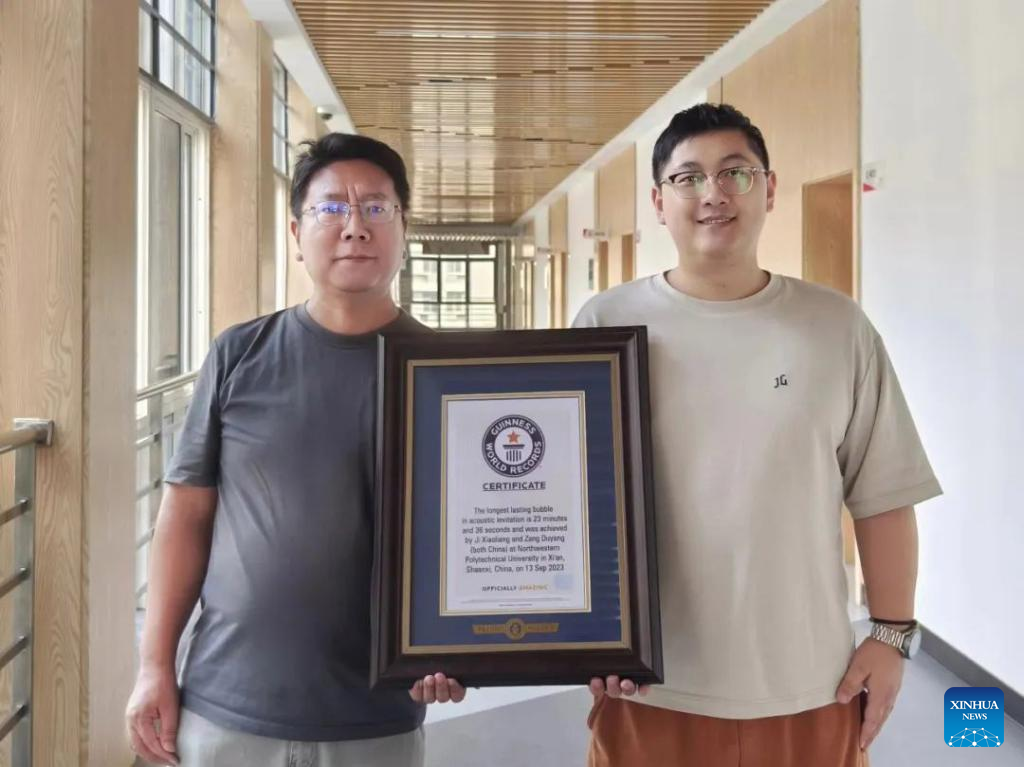
This photo taken with a mobile phone shows professor Zang Duyang (L) posing with a Guinness World Records certificate in Xi'an, northwest China's Shaanxi Province, Sept. 30, 2024. (Northwestern Polytechnical University/Handout via Xinhua)
XI'AN, Oct. 23 (Xinhua) -- Physicist Zang Duyang never expected that the bubble-making game he enjoyed as a child could continue to captivate him even in his middle-aged days, let alone that it shed light on environmental protection and developing advanced material.
Zang and his team from the School of Physics Science and Technology at Northwestern Polytechnical University recently received a special delivery -- a Guinness World Records certificate for creating "longest lasting bubble in acoustic levitation," with a duration of 23 minutes and 36 seconds, which even remained intact when pierced by a 0.8 mm diameter heated copper needle.
The achievement was made on Sept. 13 2023 by Zang's team, which used a standing wave acoustic field to levitate bubbles and achieve extraordinary bubble stability, according to the Guinness World Records official website.
"This method can increase the bubble life dramatically, and they aimed to inspire research on bubble physics and stimulate the potential applications of bubbles in various fields," it said.
Due to their unique interfacial properties, bubbles have broad prospects for applications in fields such as materials engineering, fluid physics, life sciences, and environmental sciences.
However, bubbles are inherently unstable, and naturally occurring bubbles often only last for a few seconds before bursting upon contact. Extending the lifespan of bubbles has become an interesting challenge for many scholars and engineers in the study of fluid physics and soft matter.
Some researchers use surfactants or micro/nanoparticles as stabilizers to inhibit gravity-induced drainage and thus extend the bubble life. However, the addition of chemical stabilizers inevitably leads to bubble "contamination."
To create chemical-free bubbles, researchers had made experiments on the international space station. They made use of the microgravity conditions there to inhibit the discharge of liquids, and achieved the stability and long life of pure water bubbles. However, the cost of making such long-lived bubbles is extremely high, and it is not easy to combine with other research tools for complex experimental design, according to Zang.
Zang's team has long been focused on the study of soft matter and complex fluids, with particular attention to the physical, mechanical and chemical coupling of soft matter interfaces.
Inspired by the acoustic levitation technology developed by his mentor, Wei Bingbo, a renowned materials scientist in China and an academician of the Chinese Academy of Sciences, Zang and his undergraduate students embarked on an interesting experiment of "blowing bubbles" using ultrasound.
"Since ultrasound can levitate liquid droplets without falling, can it keep the liquid in the bubble liquid film from flowing downward (draining)? We decided to find the answer in experiments," Zang said.
In one experiment, the research team accidentally discovered that under acoustic levitation conditions, liquid droplets can transform into bubbles, and these acoustically levitated bubbles have a significantly longer lifespan compared to conventional bubbles, even remaining intact when punctured with a needle.
"Why are bubbles so sturdy and long-lasting in an acoustic field?"
The team delved into this question and revealed that the super stability of acoustically levitated bubbles is due to the significant suppression of gravity drainage caused by the acoustic radiation force on the inner and outer surfaces of the bubbles.
This results of the research was published as a cover story in the international academic journal Droplet and later was reported by Nature.
The team proposed that the stability of acoustically levitated bubbles, formed by the mechanism of sound cavity resonance, is significantly enhanced, allowing them to exist for over 15 minutes in an ultrasound environment.
Even without the stabilizing effect of any surfactants, pure water bubbles can remain stable for more than seven minutes, which is a great improvement compared to conventional bubbles.
These solid surface-free, chemically "clean," and super stable acoustically levitated bubbles hold great potential for scientific research and industrial production, Zang said.
For example, the ultra-stable bubbles help to measure the surface tension of liquids and their rheological properties and can be used as liquid-based materials for collecting and analyzing aerosol particles -- a key for air pollution control.
These bubbles can also be used as ideal biological or chemical reactors for liquid templates for crystal growth and cell culture, said Zang.
In the future, Zang's team will continue to carry out research on acoustic levitated bubbles, exploring the surface properties of bubbles and their dynamics and thermodynamics to provide theoretical support for their practical applications in the fields of materials engineering, fluid physics, and life sciences. ■

A research team from the School of Physics Science and Technology at Northwestern Polytechnical University, led by professor Zang Duyang (C), pose for a group photo in Xi'an, northwest China's Shaanxi Province, April 17, 2024. (Northwestern Polytechnical University/Handout via Xinhua)

This video screenshot provided by the Northwestern Polytechnical University shows details of a bubble in acoustic levitation punctured with a needle. (Northwestern Polytechnical University/Handout via Xinhua)

This combo photomicrograph provided by the Northwestern Polytechnical University shows the bubbles in acoustic levitation made with different liquid and their related experiment data. (Northwestern Polytechnical University/Handout via Xinhua)



